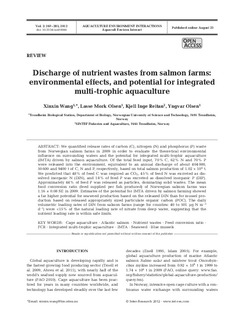| dc.contributor.author | Wang, Xinxin | |
| dc.contributor.author | Olsen, Lasse Mork | |
| dc.contributor.author | Reitan, Kjell Inge | |
| dc.contributor.author | Olsen, Yngvar | |
| dc.date.accessioned | 2019-10-14T06:03:18Z | |
| dc.date.available | 2019-10-14T06:03:18Z | |
| dc.date.created | 2012-08-13T16:18:20Z | |
| dc.date.issued | 2012 | |
| dc.identifier.citation | Aquaculture Environment Interactions. 2012, 2 (3), 267-283. | nb_NO |
| dc.identifier.issn | 1869-215X | |
| dc.identifier.uri | http://hdl.handle.net/11250/2621792 | |
| dc.description.abstract | We quantified release rates of carbon (C), nitrogen (N) and phosphorus (P) waste from Norwegian salmon farms in 2009 in order to evaluate the theoretical environmental influence on surrounding waters and the potential for integrated multi-trophic aquaculture (IMTA) driven by salmon aquaculture. Of the total feed input, 70% C, 62% N and 70% P were released into the environment, equivalent to an annual discharge of about 404000, 50600 and 9400 t of C, N and P, respectively, based on total salmon production of 1.02 × 106 t. We predicted that 48% of feed C was respired as CO2, 45% of feed N was excreted as dissolved inorganic N (DIN), and 18% of feed P was excreted as dissolved inorganic P (DIP). Approximately 44% of feed P was released as particles, dominating solid wastes. The mean food conversion ratio (feed supplied per fish produced) of Norwegian salmon farms was 1.16 ± 0.08 SE in 2009. Estimates of the potential for IMTA driven by salmon farming showed a far higher potential for seaweed production based on the released DIN than for mussel production based on released appropriately sized particulate organic carbon (POC). The daily volumetric loading rates of DIN from salmon farms (range for counties: 40 to 501 µg N m−3 d−1) were <15% of the natural loading rate of nitrate from deep water, suggesting that the nutrient loading rate is within safe limits. | nb_NO |
| dc.language.iso | eng | nb_NO |
| dc.publisher | Inter-Research Science Publisher | nb_NO |
| dc.rights | Navngivelse 4.0 Internasjonal | * |
| dc.rights.uri | http://creativecommons.org/licenses/by/4.0/deed.no | * |
| dc.title | Discharge of nutrient wastes from salmon farms: environmental effects, and potential for integrated multi-trophic aquaculture | nb_NO |
| dc.type | Journal article | nb_NO |
| dc.type | Peer reviewed | nb_NO |
| dc.description.version | publishedVersion | nb_NO |
| dc.source.pagenumber | 267-283 | nb_NO |
| dc.source.volume | 2 | nb_NO |
| dc.source.journal | Aquaculture Environment Interactions | nb_NO |
| dc.source.issue | 3 | nb_NO |
| dc.identifier.doi | 10.3354/aei00044 | |
| dc.identifier.cristin | 938454 | |
| dc.description.localcode | Copyright © 2012 Inter-Research. Open Access CC-BY | nb_NO |
| cristin.unitcode | 194,66,10,0 | |
| cristin.unitname | Institutt for biologi | |
| cristin.ispublished | true | |
| cristin.fulltext | original | |
| cristin.qualitycode | 1 | |

